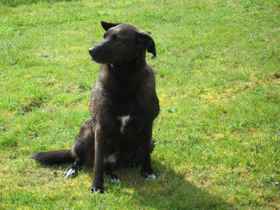Aromatherapy For Pets.
Natural Aromatherapy Healthcare...

Why aromatherapy for pets?
There are many ways that essential oils and hydrosols can be beneficial for our pets. If it works for us....why shouldn't it work for our pets?
Some oils will help physically with minor ailments such as itching, ear infections, fleas and ticks, but there are certain oils that also work on an emotional level, calming and relaxing your animals.
The methods used are pretty much the same as those used with humans. The essential oils and hydrosols are either inhaled or mixed with a carrier oil and massaged into the skin.
Another obvious use for aromatherapy for pets is to help get rid of those bad odours that can occur! Believe me I know too well about this after my dog Tweeny, (pictured above), has taken a swim in a nearby lake, or decided to roll in something very smelly!
Dogs and horses are the two types of animals that are best suited to the use of essential oils. Hydrosols are considered to be safer for cats and smaller animals.
So.....what are the physical benefits of aromatherapy for pets?
- Essential oils are effective flea and tick repellants, so you can make an easy flea and tick spray.
- Good for itchy skins and rashes.
- Useful for boosting your pets immune system.
- Can help joint conditions, digestive problems, respiratory conditions and circulatory problems.
What are the emotional benefits of pet aromatherapy?
- Essential oils are mostly used to calm and relax animals. For example, if you massage an aromatherapy blend into the chest and neck of a dog you wish to calm, the essential oils will not only be absorbed into the skin but also evaporate from the fur and be inhaled.
- Using aromatherapy blends with animals will involve your human touch and this is something that your pet absolutely loves and needs.
- They can help with emotional issues such as anxiety, nervousness, stress, and those that are hormone related.
What is the best way to use aromatherapy for pets?
There are so many different essential oils out there that it can be a minefield trying to decide which to choose! Which ones are safe for your pet? How many do you need? How do you apply them?
The answer will depend on what sort of pet you have, and what you are trying to treat.
Get permission from your pet! As odd as that may sound, a dog or horse's nose is much more acute at smelling than our own. They may not like the aroma of the essential oils you are trying to use. Let them smell the oils before you use them and see how they react. Your pet probably likes it if they sniff it and seem interested. If they turn their heads away and don't want to know......they probably don't like it! Sneezing, whining, pacing and teary eyes can be a sign that your pet is overwhelmed.
Make sure you dilute your essential oils well in a good quality base oil such as sweet almond oil or jojoba oil. A rough guideline is to add about 8-10 drops of essential oils to 20 ml of carrier oil.
It is a good idea to start off by using a mild solution and to monitor your pet the first few times you use aromatherapy blends with them.
Knowing the properties of the oils you are using is a wise move as some oils do have side-effects (such as lemon which is photo-toxic and can burn skin if exposed to sunlight within twelve hours of application).
However, we do have to be a little bit careful with aromatherapy for pets, as animals are different to humans, so that essential oils and blends that we use on ourselves are not always safe for our pets.
Here are some aromatherapy for pets precautions.....
- It is best not to use essential oils on cats and smaller animals (kittens, puppies, rabbits, ferrets, small dogs, birds). Their bodies may be unable to handle them effectively, so they may become ill or even die.
- Do not use essential oils directly on sick animals.
- Always use 100% pure, therapeutic grade essential oils on animals (just as you should on humans!).
- Always dilute essential oils before using them on your pets. (Dilution is roughly 8-10 drops for every 20 ml.)
- Do not give essential oils internally.
- Don't leave essential oil bottles lying around in reach of your pets......animals have been known to eat them!
- Essential oils are natural but are also highly concentrated and therefore potent. It is always a good idea to check with your vet or a qualified animal therapist before using aromatherapy blends.
- There have been concerns about using essential oils on pregnant animals. It is believed that some oils such as basil, clary sage, sage, marjoram, ylang ylang, cinnamon, thyme and fennel may cause a miscarriage due to their properties.
- Be very careful with eyes, noses, anal and genital areas when using oils. Stay well away!
- If your pet is on any medication then check with your vet before using aromatherapy. If you have any concerns at all, always consult your vet.
What about using hydrosols? And what are they?
Using hydrosols in aromatherapy for pets is certainly an alternative. In fact, it is thought to be safer to use these on cats, puppies, small animals, young horses and sick animals.
Hydrosols are a by-product of essential oils, but they still have the wonderful healing properties because they contain the essence of the plants. They are also more affordable than essential oils, making them a great choice for animal aromatherapy.
Please keep coming back.............coming soon:
- More information about aromatherapy for dogs and some recipes using essential oils to try!
- More about aromatherapy for cats.
- More details about hydrosols.